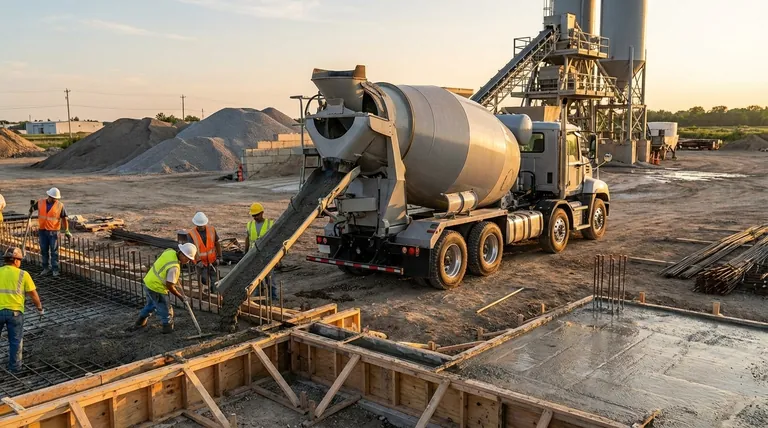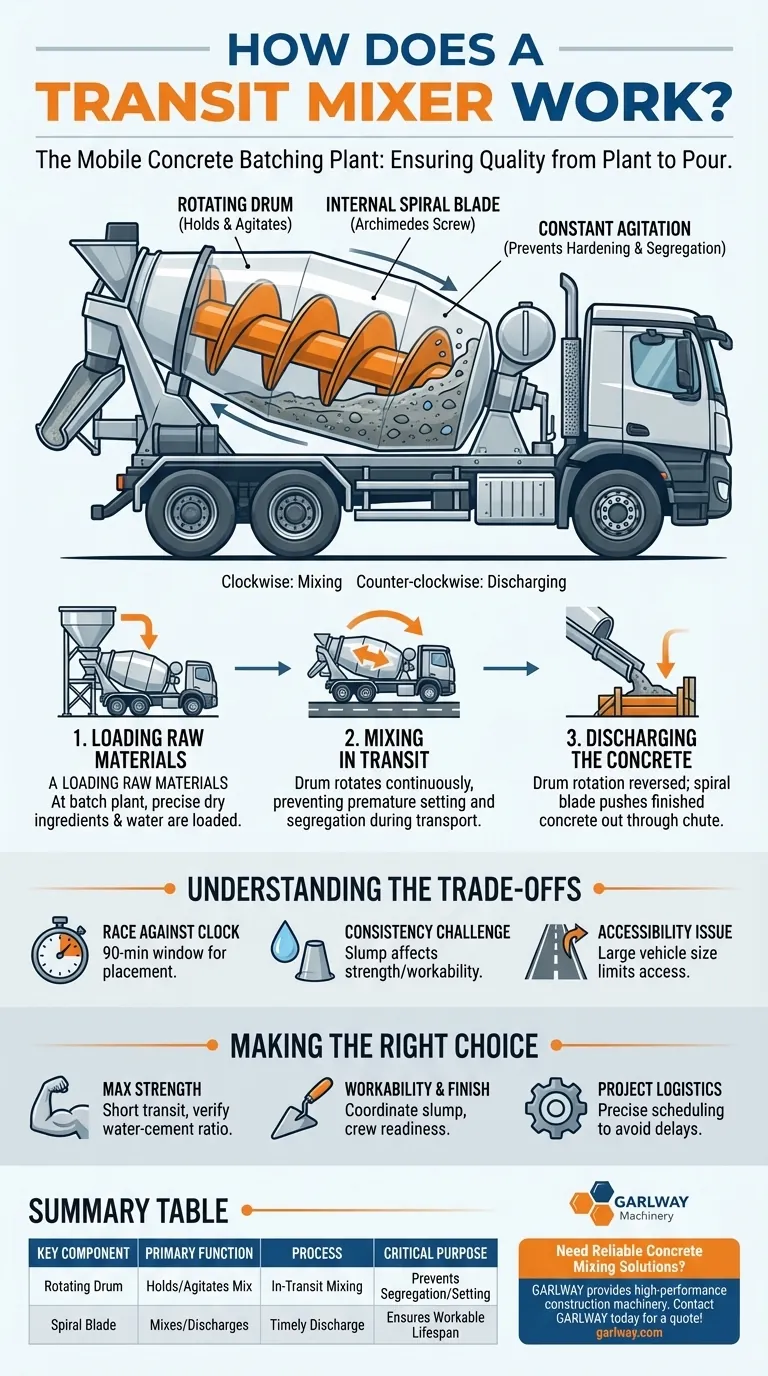At its core, a transit mixer works by continuously rotating a drum filled with concrete ingredients during transport. This constant agitation, driven by a spiral blade inside the drum, serves the critical purpose of preventing the concrete from hardening or separating before it reaches the construction site.
The transit mixer is not just a delivery truck; it's a mobile concrete batching plant designed to maintain the precise quality and workability of freshly mixed concrete from the moment it's loaded to the moment it's poured.

The Core Components and Their Function
To understand how a transit mixer operates, we must first look at its key parts. Each component is engineered to solve a specific challenge related to transporting a perishable, time-sensitive material like concrete.
The Rotating Drum
The most prominent feature of the mixer is its large, rotating drum, which is mounted on the truck chassis. This drum is the vessel where the concrete is held and mixed.
Its constant, slow rotation on its own axis is the fundamental principle of the machine's operation. This movement ensures the heavy aggregates, sand, cement, and water remain a uniform, liquid-like mixture, known as a homogenous slurry.
The Internal Spiral Blade
Inside the drum is a continuous spiral blade, much like an Archimedes screw. This blade is the true workhorse of the mixer.
The direction of the drum's rotation determines the blade's function. When rotating in one direction (typically clockwise), the blade continuously folds the concrete back towards the front of the mixer, ensuring thorough agitation. When the rotation is reversed, the same blade acts as a conveyor, pushing the mixed concrete out through the discharge chute.
The Critical Process: From Plant to Pour
The operation follows a precise sequence designed to deliver ready-to-use concrete with predictable properties.
Loading Raw Materials
The process begins at a concrete plant, or "batch plant." Here, precisely measured amounts of dry materials (cement, sand, aggregates) and water are loaded into the mixer's drum through a large hopper at the top rear of the vehicle.
Mixing in Transit
As soon as the truck is loaded, the drum begins to rotate. This "in-transit" mixing is what gives the vehicle its name.
The constant agitation prevents two primary problems:
- Segregation: It stops the heavier aggregates from settling at the bottom of the mix.
- Premature Setting: It keeps the mixture active, preventing the chemical reaction of hydration (hardening) from completing too early.
Discharging the Concrete
Upon arrival at the job site, the truck operator reverses the direction of the drum's rotation. The internal spiral blade then efficiently pushes the finished concrete up and out through the discharge chute, allowing for a controlled pour directly into forms, pumps, or wheelbarrows.
Understanding the Trade-offs
While essential, the transit mixer system is not without its operational constraints. Understanding these is key to successful project management.
The Race Against the Clock
Fresh concrete has a limited workable lifespan, typically around 90 minutes to a few hours, depending on the mix design and ambient temperature. The entire process—loading, travel, and discharging—must be carefully scheduled within this tight window.
The Consistency Challenge
The "slump," or consistency, of the concrete is critical for its final strength and workability. Traffic delays or high temperatures can cause water to evaporate, altering the carefully designed water-to-cement ratio and potentially compromising the pour.
The Accessibility Issue
Transit mixers are large, heavy vehicles. Their size and weight can limit access to tight or remote job sites, requiring careful logistical planning to ensure they can get close enough to the pour location.
Making the Right Choice for Your Goal
Your approach to using a transit mixer should align directly with your project's most critical outcome.
- If your primary focus is maximum concrete strength: Ensure the shortest possible transit time and verify the water-cement ratio has not been altered on-site before the pour.
- If your primary focus is workability and finish: Coordinate with the supplier on the desired "slump" and ensure the crew is ready to place and finish the concrete immediately upon its arrival.
- If your primary focus is project logistics: Schedule the mixer's arrival with precision to avoid having a crew waiting or a truck full of hardening concrete sitting idle due to site unpreparedness.
Ultimately, the transit mixer is a specialized tool engineered to overcome the fundamental challenge of moving a perishable construction material, ensuring quality and consistency right where you need it.
Summary Table:
| Key Component | Primary Function |
|---|---|
| Rotating Drum | Holds and continuously agitates the concrete mix. |
| Spiral Blade | Mixes concrete in one direction; discharges it when reversed. |
| Process | Critical Purpose |
| In-Transit Mixing | Prevents segregation and premature setting of concrete. |
| Timely Discharge | Ensures concrete is poured within its limited workable lifespan. |
Need Reliable Concrete Mixing Solutions for Your Project?
GARLWAY specializes in providing high-performance construction machinery, including robust transit mixers, for construction companies and contractors worldwide. Our equipment is engineered for durability and efficiency, ensuring your concrete arrives on-site with the perfect consistency every time.
Let us help you streamline your operations and guarantee project success.
Contact GARLWAY today to discuss your specific needs and get a quote!
Visual Guide

Related Products
- Portable Concrete Mixer Machine Equipment for Mixing Concrete
- Portable Ready Mix Concrete Mixer Equipment
- JZC400 Mobile Small Concrete Mixer Cement Mixer Machine
- Ready Mixer Machine for Construction Ready Mix Machinery
- JW1000 Mobile Cement Mixer Concrete Mixer Truck and Batching Plant
People Also Ask
- How much concrete can you pour with a portable mixer? Find the Perfect Fit for Your Project
- What are the disadvantages of ready mixed concrete? Navigate Logistical & Cost Risks
- What are the components of concrete mixing? Master the Ingredients and Machinery for Perfect Results
- How much does a portable concrete mixer hold? A Guide to Choosing the Right Capacity
- How long does it take to mix concrete in a portable mixer? Master the 60-Minute Rule
















